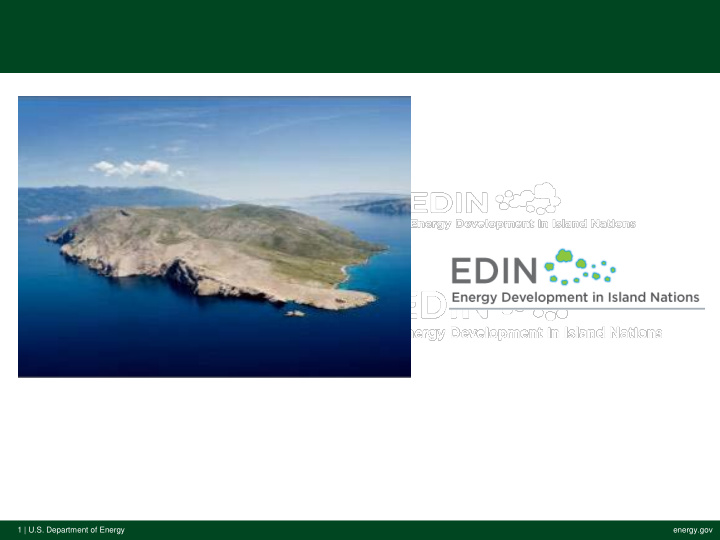



1 | U.S. Department of Energy energy.gov
Energy Development in Island Nations (EDIN) - Purpose Why Islands? Islands are often highly dependent on fossil fuels for electricity and transportation and often have very high retail electricity rates. • For example, Hawaii pays three times the national average for electricity; CNMI $0.33/kWh; Cayman Islands $0.70/kWh (U.S. average in 2008 is $0.10/kWh). Islands often have abundant renewable resources and small populations, so are ideal places to showcase the potential of renewable energy penetration. • Through the Hawaii Clean Energy Initiative (HCEI), DOE is working in Hawaii to supply 70% of primary energy from renewable energy by 2030 – EDIN builds on this initiative. Islands are vulnerable to the impacts of climate change, such as sea level rise and greater severity and frequency of hurricanes. EDIN aims to facilitate the scaling of renewable energy and energy efficiency technologies in island nations and territories 2 | U.S. Department of Energy energy.gov
EDIN Participants • Partnership began officially in August 2008, with Iceland, New Zealand and U.S. (DOE/EERE) as founding members. • EDIN will build upon the HCEI model of transforming an island with existing electrical infrastructure to a clean energy economy through technical, financial and policy assistance. • April 2009 – EDIN announced three pilots projects. – The U.S. (DOE and DOI) is working with U.S. Virgin Islands towards a clean energy goal of 60% fossil fuel reduction by 2025. – Iceland provided analysis of Dominica’s geothermal resources. – New Zealand conducted a survey of geothermal potential in numerous Pacific islands, working with select islands to gauge potential of utilizing these resources. • EDIN provided the first Island Energy Symposium in October 2010 in CNMI with over 50 participants. 3 | U.S. Department of Energy energy.gov
EDIN Activities – General Ongoing general activities of EDIN: Creating knowledge modules for replicable model for islands to – transform to clean energy economy – e.g. , model templates of EE/RE policies and contracts – that will be accessed via EDIN website Visits and exchanges of experts to island sites/conferences in – the policy, finance, and technology areas Establishing of a network of project developers and financiers – Drafting detailed case studies of island EE/RE projects on – website Organizing collaboration with other agencies; multi-lateral – institutions; regional bodies (CARICOM; Pacific Islands Forum) Working to expand membership to include other countries and – organizations to enhance expertise and influence Developing content on website to aid in transferring knowledge – and lessons learned (currently developing a “ toolkit ” ) Ultimately becoming a clearinghouse of island EE/RE energy- – related information www.edinenergy.org Contact: Daniel.Birns@ee.doe.gov 4 | U.S. Department of Energy energy.gov
United States & US Virgin Islands Goal: Reduce fossil fuel use by 60% by 2025! USVI plans to focus on: • Utility scale wind and solar PV • Distributed solar PV • Solar water heaters • Landfill methane capture and use 100% Oil • Waste to energy feasibility • 80 MW (St. Thomas + St. John) • 50 MW (St. Croix) • Grid integration and stability 108,000 people • Incentivizing energy efficiency • 30% below poverty line • Exploring utility interconnection Currently $0.33/kWh with Puerto Rico • Up to $0.51/kWh in 2008. 5 | U.S. Department of Energy energy.gov
EDIN – US Virgin Islands Early Success Stories Feb 2010 – MOU signed between DOE/DOI/USVI. Governor announces goal of 60% reduction in fossil fuel by 2025. June 2010 – Five broad-based working groups are formed around Renewable Energy, Energy Efficiency, Transportation, Policy, and Outreach & Workforce Development. Aug 2010 – Kick-off of interconnection study with Puerto Rico. This interconnection would enable higher penetration RE. Dec 2010 – Completed HOMER analysis shows high- penetration of wind and solar will reduce utility’s costs. Jan 2011 – ESCO signs $7.5M contract to retrofit schools for the Department of Education. Feb 2011 – Ground breaking on 400kW solar PV project – by far the largest PV project to date in USVI. Feb 2011 – Utility completes RFP for 10 MW of solar (8% of peak load). RFP to be released in March 2011. 6 | U.S. Department of Energy energy.gov
Additional Information • See the EDIN website: www.edinenergy.org 7 | U.S. Department of Energy energy.gov
Recommend
More recommend